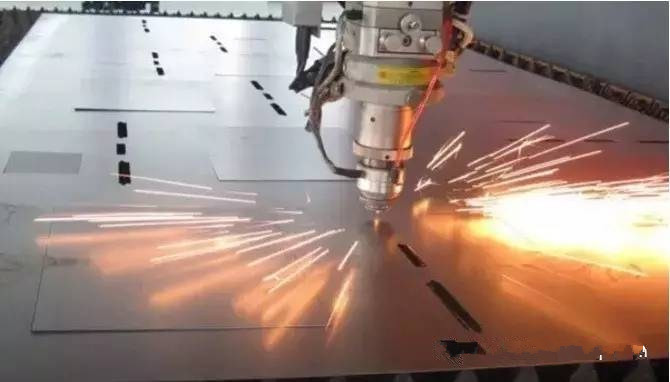
See more categories +
The Application of Laser Manufacturing Technology in the Automotive Industry
Categories: Industry News
Time of issue:2017-01-04 13:38
In recent years, laser manufacturing technology has permeated high-tech fields and industries, gradually replacing or transforming certain traditional manufacturing sectors. Increasingly, laser manufacturing technology is playing a crucial role in elevating the R&D and production capabilities of the automotive industry.
Laser manufacturing refers to the general term for processes or shaping techniques that utilize lasers to interact with materials according to specific requirements. Over the past two decades, laser manufacturing technology has increasingly integrated into high-tech fields and industries, gradually replacing or transforming certain traditional manufacturing sectors. In the automotive industries of developed countries, 50% to 70% of components are now produced using laser processing. As a result, laser manufacturing technology is playing an increasingly vital role in elevating both the research and development as well as the overall production capabilities of the automotive industry.
I. Characteristics of Laser Manufacturing Technology
Currently, the primary light source used in laser manufacturing technology is the laser itself. Laser beams are characterized by their high energy density, high monochromaticity, and excellent directivity, giving laser manufacturing technologies numerous advantages that surpass those of conventional manufacturing methods. The tool employed in this technology is essentially a "laser knife," which ensures zero tool wear during operation. Moreover, since there’s no cutting force involved in the process, workpieces remain free from cold-working deformation. Additionally, due to the rapid energy input during processing, the thermal impact on the material is minimal, resulting in negligible thermal distortion. This allows the process to closely mimic or even achieve "cold" machining conditions, enabling ultra-precise fabrication that conventional techniques cannot accomplish.
Laser technology also boasts exceptional spatial control capabilities—enabling precise adjustments such as beam direction changes, rotation, and scanning—as well as remarkable temporal control over features like switching on/off and pulse intervals. These attributes make lasers particularly well-suited for automated manufacturing, significantly boosting productivity in large-scale production environments.
Furthermore, laser processing offers unparalleled flexibility in handling materials of various types, shapes, sizes, and even diverse processing environments. It generates minimal noise, produces no harmful radiation or hazardous waste, and poses little environmental impact throughout the manufacturing process.
Finally, laser-based methods eliminate the need for costly molds, drastically reducing product development timelines and lowering associated costs. This approach also minimizes material waste, making it highly efficient for large-scale production while keeping manufacturing expenses competitively low.
II. Categories of Laser Manufacturing Technologies in the Automotive Industry
Laser manufacturing technologies in the automotive industry can be categorized into three types: laser "cold" processing, laser "hot" processing, and laser rapid prototyping.
1. Laser "Cold" Processing Technology
Laser manufacturing technologies corresponding to conventional cold-working processes include laser cutting, laser drilling, laser marking, and laser machining.
Laser cutting is fast, producing smooth and even cuts with excellent edge parallelism—eliminating the need for additional post-processing. The kerf is narrow, and the cut edges remain free of mechanical stress and shear burrs. Moreover, this process delivers high precision, outstanding repeatability, and ensures no damage to the workpiece surface.
Laser drilling is fast and highly efficient, making it ideal for processing large quantities of high-density cluster holes. It can achieve a significant depth-to-diameter ratio and is capable of machining materials ranging from hard and brittle to soft—plus, it even allows for the creation of tiny holes on inclined surfaces of difficult-to-process materials. Additionally, laser drilling is a clean process that generates no pollution.
Laser marking is a non-contact marking process that is fast and produces marks that are highly resistant to wear. Moreover, laser marking machines can easily be integrated into production lines.
Laser cutting is a process similar to milling in mechanical machining—it uses a focused laser beam to progressively cut through the material layer by layer.

2. Laser "Thermal" Processing Technology
Corresponding laser manufacturing technologies to conventional thermal processing methods include laser welding, laser surface hardening, laser cladding, and laser alloying.
Laser welding is a process that uses a high-intensity laser beam to locally heat the metals to be joined, melting them above their melting point and fusing them together to form a weld joint. It can weld special materials such as high-melting-point metals, non-metals, and composite materials, and is also capable of joining dissimilar materials as well as creating complex structural welds. The weld exhibits a "self-cleaning" effect, resulting in high-quality welds. Additionally, laser welding allows for precise fabrication with minimal need for filler metal. By integrating the laser beam with advanced optical systems and multiple pieces of equipment, it forms a flexible processing system, enabling highly automated welding and significantly boosting production efficiency. Among high-energy beam welding techniques, laser welding stands out for its unique advantage: it doesn’t require a vacuum chamber and does not generate X-rays during the process.
Laser surface strengthening is divided into two types: laser phase transformation hardening and laser melt-quenching hardening. Laser phase transformation hardening, also known as laser quenching, involves rapidly scanning a workpiece with a high-energy laser beam, causing the temperature of the irradiated metal or alloy surface to rise extremely quickly—well above the phase transformation point. As the laser beam moves away from the irradiated area, heat conduction allows the cooler substrate material to cool rapidly, resulting in self-quenched hardening and forming a finer hardened microstructure with hardness typically higher than that achieved through conventional quenching methods. In contrast, the laser melt-quenching process follows a similar principle, except that the laser heats the material's surface to an even higher temperature, ultimately creating a fine-grained melt-quenched layer on the part's surface.
Laser cladding involves using a high-energy laser beam to irradiate the cladding material, causing it to rapidly melt and solidify along with a thin surface layer of the substrate, thereby forming an alloy coating with completely different composition and properties that achieves metallurgical bonding with the substrate.
3. Laser Rapid Prototyping Technology
The principle of laser rapid prototyping technology involves using a laser beam, under computer control, to selectively solidify layered forming materials according to the CAD design models and data of the part. This process builds the part's surfaces (layers) by precisely stacking points and lines, ultimately creating a three-dimensional实体 model or finished component. By leveraging laser rapid prototyping, product development cycles can be significantly shortened, and development costs dramatically reduced. Moreover, this technology enables the swift production of products that can quickly adapt to market changes, helping companies maintain and enhance their competitive edge in the marketplace. At the same time, laser rapid prototyping serves as an effective technological approach for implementing concurrent engineering and agile manufacturing practices.
The automotive industry is entering a lean production phase characterized by flexible manufacturing that can meet customers' specific requirements. A flexible, modular production approach has emerged in the auto sector, and the modern automotive industry is increasingly moving toward cutting-edge, high-tech advancements. Automotive technology is undergoing a transformative shift—from traditional mechanical manufacturing techniques to advanced, intelligent, and automated production methods. Laser manufacturing technology has injected new vitality into the development, prototyping, and production processes of automobiles. Looking ahead, it’s safe to predict that laser-based manufacturing technologies will see rapid growth and widespread adoption in the automotive industry, ultimately becoming a crucial processing method for carmakers. (Source: JiaGong Machinery & Electrical Network)




